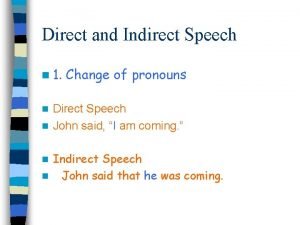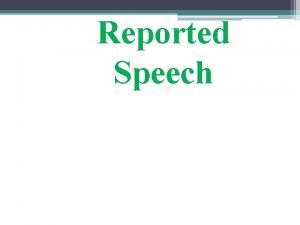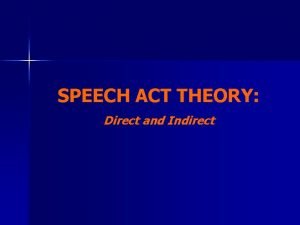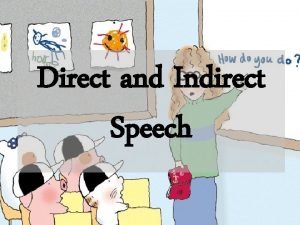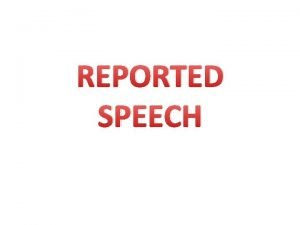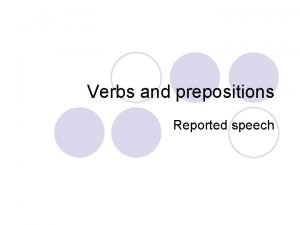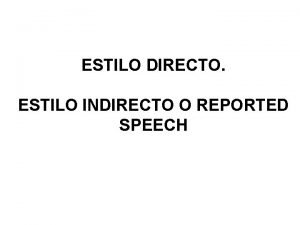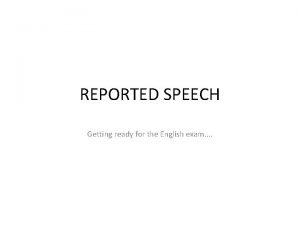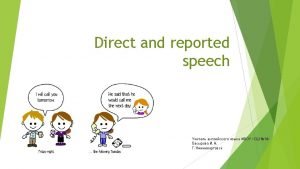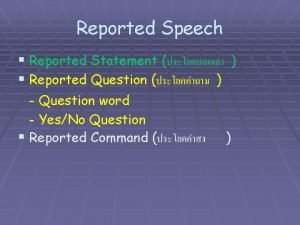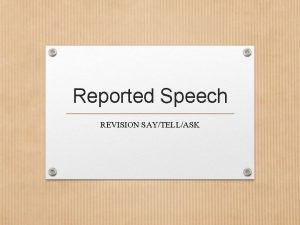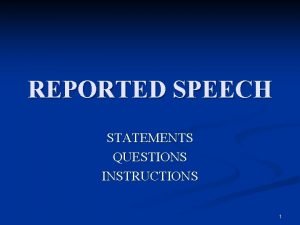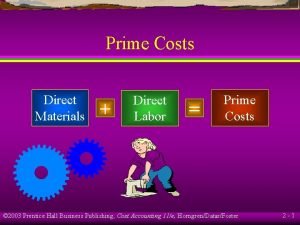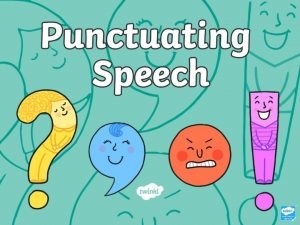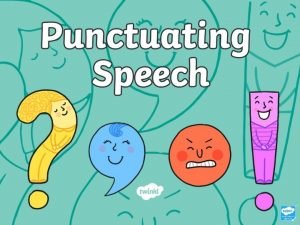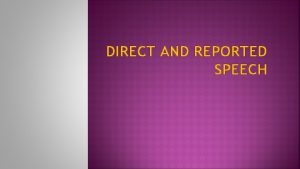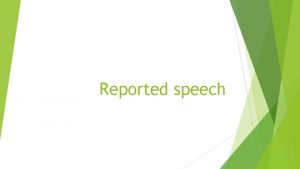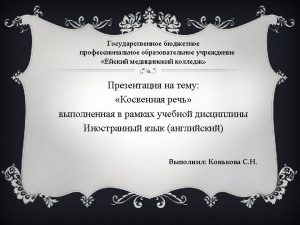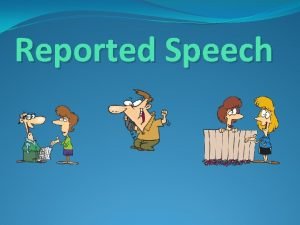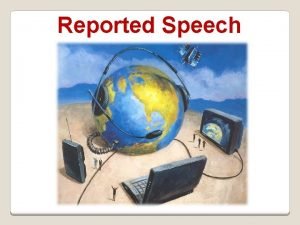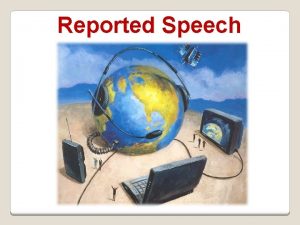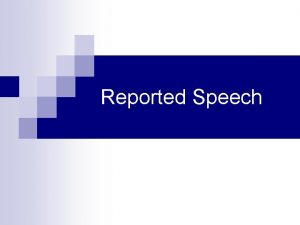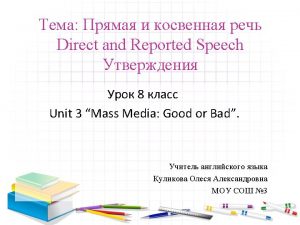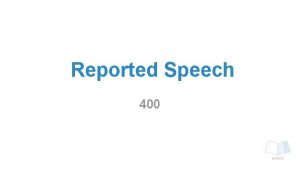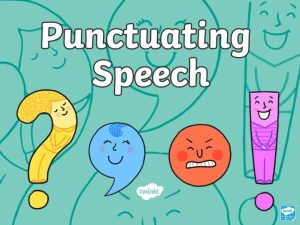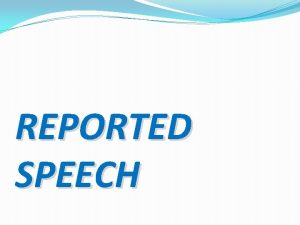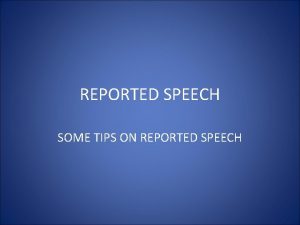Reported Speech vs Direct Speech Reported speech summarises

















- Slides: 17


Reported Speech vs. Direct Speech Reported speech summarises or paraphrases what has been said. It does not usually directly quote the words spoken, so does not need any special punctuation. For example: The goats said that they wanted to eat the green grass on the other side of the bridge. The troll shouted to the goats to stay on their own side of the stream.

Reported Speech vs. Direct Speech When a text uses direct speech, some specific punctuation conventions are required to separate what is said from the rest of the text; this enables the reader to follow what is going on.

Inverted Commas The most important rule in punctuating direct speech is that all words spoken must be enclosed by inverted commas. In British English, a single inverted comma may be used: ‘Get off my bridge. ’ However a double inverted comma may also be used: “Get off my bridge. ” Whichever style you choose, use it consistently across a text.

Punctuation Inside Inverted Commas All commas, full stops, question marks and exclamation marks must also be enclosed by inverted commas. For example: ‘That grass looks delicious, ’ said the smallest Billy Goat Gruff. ‘Hey, goat!’ shouted the troll. ‘You are not allowed to cross my bridge. ’ ‘How can we get to the other side? ’ asked the Biggest Goat Gruff. NOT: ‘Get off my bridge ’ ! shouted the troll.

Commas are another important tool to help the reader separate direct speech from the rest of the text. Where direct speech precedes a verb, and does not end in a question mark or exclamation mark, a comma must be used. For example: ‘We need to get to the other side, ’ moaned the goats. ‘Those goats are always disturbing my sleep, ’ muttered the troll.

Commas Where the direct speech before a verb ends in a question mark or exclamation mark however, this punctuation replaces the comma. For example: ‘Who goes there ? ’ shouted the troll. NOT: ‘Who goes there ? , ’ shouted the troll.

Commas Where the direct speech follows a verb, a comma must be used after the verb to indicate that direct speech is about to begin. Note: in this context, the direct speech must always begin with a capital letter. For example: The smallest Billy Goat Gruff said, ‘I’ll go first. ’ The Troll shouted, ‘Who goes there? ’ The biggest Billy Goat Gruff shouted, ‘Oh no you won’t!’

Punctuation Inside Inverted Commas In addition, where the direct speech follows the verb, a full stop, exclamation mark or question mark must be used inside the inverted commas to signal the end of the speech. For example: The smallest Billy Goat Gruff said, ‘I’ll go first. ’ The Troll shouted, ‘Who goes there? ’ The biggest goat shouted, ‘Oh no you won’t!’

Punctuating ‘Split’ Direct Speech If the direct speech is one sentence broken up by information about who is speaking, you need a comma (or a question mark or exclamation mark) to end the first piece of speech and another comma before the concluding part of the sentence (before the inverted comma or commas). For example: ‘I’m light and quiet, ’ said the smallest Billy Goat Gruff, ‘so I’ll go first. ’ In this context, use a lower case letter to start the second part of the direct speech.

Punctuating ‘Split’ Direct Speech If the direct speech is two discrete sentences separated by information about who is speaking, you need a comma (or a question mark or exclamation mark) to end the first piece of speech and full stop after the information about the speaker. The second sentence then begins with a capital letter. For example: ‘You’re right, ’ agreed the Biggest Billy Goat Gruff. ‘We can’t let the Troll beat us. ’

New Speaker, New Line If the direct speech in a text involves more than one speaker, a new line must be used for each new speaker. This helps the reader to follow what is being said. For example: ‘We can’t let him win! He’s just a grumpy troll!’ said the smallest Billy Goat Gruff. ‘You’re right, ’ agreed the biggest Billy Goat Gruff. The medium-sized Billy Goat Gruff said, ‘So what shall we do? ’

Reporting Clauses Reporting clauses tell us who is speaking, or who said what. Reporting clauses can be found in both reported speech and direct speech. For example: The troll said the goats should get off his bridge. (reported speech) ‘Who goes there? ’ shouted the Troll. (direct Speech) ‘That grass looks so green and delicious, ’ bleated the Smallest Billy Goat Gruff. (direct speech)

Two-Minute Challenge Consider the following example: The troll said, ‘Get off my bridge, ’ and the goat said, ‘No!’ Technically, this example is correct; however, it is clumsy. Talk to a partner to find two ways that this example could be improved. You have two minutes! Start End Click start and the timer is up when it fades to red.

Two-Minute Challenge How did you improve this example? The troll said, ‘Get off my bridge, ’ and the goat said, ‘No!’ You could use the rule ‘new speaker, new line’: The troll said, ‘Get off my bridge. ’ ‘No!’ said the goat. You could use reported speech instead of direct speech. The troll told the goat to get off his bridge, but the goat refused. Click start and the timer is up when it fades to red. Start End

Summary Context Punctuation All reported speech No extra punctuation. All direct speech Must be enclosed in inverted commas. Direct speech punctuation Must be enclosed in inverted commas. Direct speech before a verb Use a comma after the direct speech (inside the inverted commas), verb begins with inverted comma and lower case letter. Direct speech after a verb Use a comma after the verb (outside the inverted commas), direct speech begins with inverted comma and a capital letter. Split direct speech – one sentence Use a comma/exclamation/question mark inside inverted comma to conclude first part of speech. Verb starts with lower case letter, followed by comma outside inverted commas. Direct speech resumes with an inverted comma and a lower case letter. Split direct speech – two sentences Use a comma/exclamation/question mark inside inverted comma to conclude first part of speech. Verb starts with lower case letter, followed by full stop. Direct speech resumes with an inverted comma and a capital letter.

 Direct vs indirect sentence
Direct vs indirect sentence Reported speech wh questions
Reported speech wh questions They are playing football
They are playing football Type of sentence with example
Type of sentence with example Direct and indirect speech worksheets with answers
Direct and indirect speech worksheets with answers Excuse me are you a vegetarian reported speech
Excuse me are you a vegetarian reported speech Indirect speech present simple
Indirect speech present simple Changing from direct to indirect speech
Changing from direct to indirect speech Match the verbs with the prepositions
Match the verbs with the prepositions Cambio de pronombres en reported speech
Cambio de pronombres en reported speech Reported speech form
Reported speech form Direct speech into reported speech
Direct speech into reported speech Direct speech past simple
Direct speech past simple Reported speech exercise
Reported speech exercise Reported statements with say and tell
Reported statements with say and tell Quoted and reported speech
Quoted and reported speech Quoted speech
Quoted speech Direct material + direct labour
Direct material + direct labour

